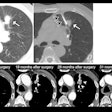Dear Digital X-ray Insider,
Scoliosis has been traditionally diagnosed by manually measuring the Cobb angle on spine x-rays. Current software tools are a huge improvement over the use of protractors and printed x-rays, noted a group in Japan, but these measurements are still time-consuming -- and this limits their use in scoliosis surgical planning.
To that end, they have developed AI for the task, and the story on the research is this issue's Insider Exclusive.
In other AI developments, researchers recently trained a model to estimate the age of patients from chest x-rays. This opens a potential path for x-rays to serve as biomarkers to assess chronic diseases, according to the group. And a team in Baltimore, MD, found that an AI algorithm trained to detect pneumonia on adult chest x-rays may also be valuable in pediatric patients.
With AI typically dominating our coverage, we noted for this issue an uptick in dual-energy x-ray absorptiometry (DEXA) stories, as seen here:
- A group in Israel found that less than half of women receiving breast cancer treatment with aromatase inhibitors undergo recommended DEXA imaging to assess their bone health.
- A group in Texas used DEXA knee scans from 29,257 individuals in a study they say supports the emerging concept of x-ray "image-based phenotyping."
- Researchers in Ireland called for a national program to reduce the osteoporosis illness burden following a DEXA study that revealed the country's prevalence for the disease.
- A DEXA study in obese patients with obstructive sleep apnea revealed that men may respond more than women to fasting, according to a group in Australia.
While DEXA showed its stripes, developers of a much newer technology -- dynamic chest radiography (DCR) -- penned a review that included more than 20 images illustrating DCR's clinical application in pulmonary vascular diseases.
Our coverage also included a study showing that chest x-ray imaging volumes are increasing at level one emergency departments; meanwhile, a group in New York City said that a simple electronic health record intervention can reduce the incidence of unnecessary x-rays for patients presenting with low back pain.
Finally, we noted that Rad-Aid International investigators reported success in deploying chest x-ray AI to help diagnose tuberculosis in Guyana and Nigeria.
That's all for now. Be sure to check back often for more news in your Digital X-Ray Community.




















